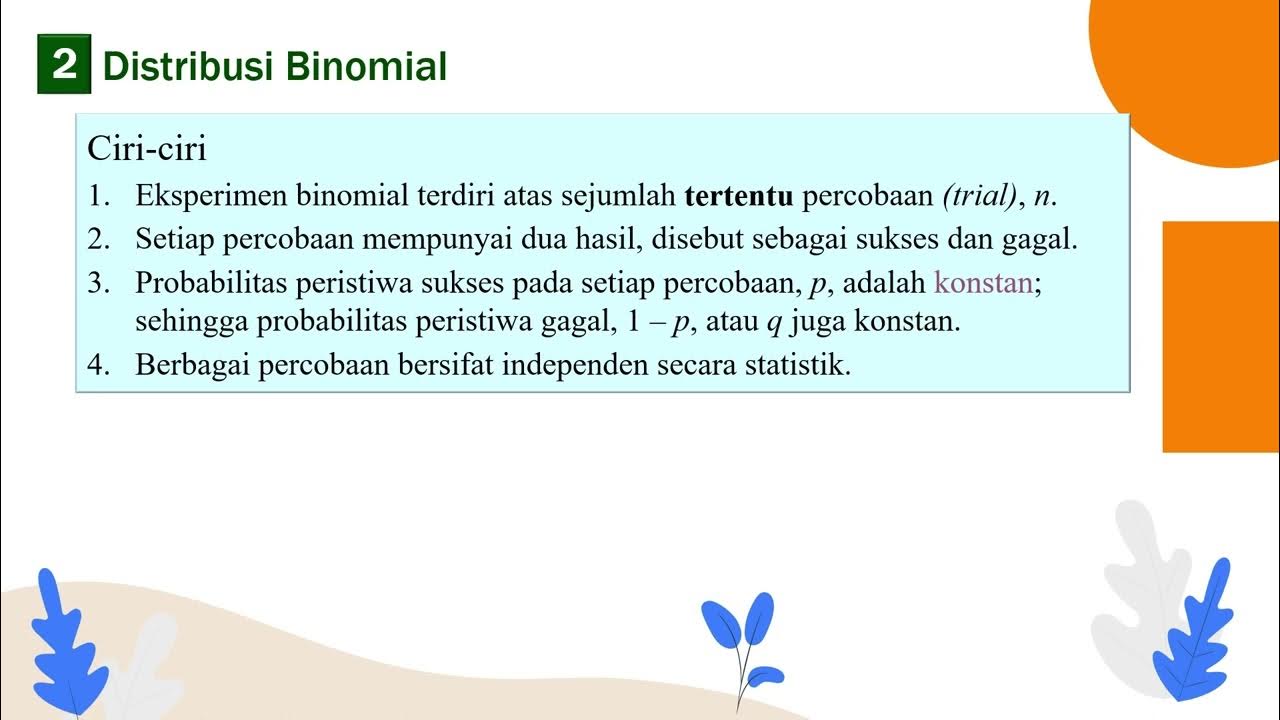02 - Random Variables and Discrete Probability Distributions
Summary
TLDRThis video provides a detailed explanation of probability distributions, focusing on discrete outcomes. Using the example of rolling two dice, the script explores how to calculate the probability of different sums, such as 2, 3, 7, or 12, based on the number of possible combinations. It highlights the importance of understanding discrete distributions, summing probabilities, and applying these concepts in real-world scenarios. The lesson also emphasizes the critical idea that the total probability of all possible outcomes must always equal 1, preparing viewers for further studies in statistics and probability.
Takeaways
- 😀 Probability distributions describe the likelihood of various outcomes in an experiment.
- 🎲 The sum of two rolled dice can range from 2 to 12, and each sum has a specific probability based on the number of combinations that result in it.
- 🔢 A discrete probability distribution consists of individual probabilities for each possible outcome, and the total probability must always sum to 1.
- 🎲 With two dice, there are 36 possible outcomes (6 faces on each die), and the probability of each outcome can be calculated by counting how many ways it can occur.
- 🧮 To find the probability of specific sums, count the number of combinations that yield the sum and divide by the total number of possible outcomes (36).
- 🔍 The sum of 2 can only occur in one way (1+1), while sums like 7 can occur in multiple ways (1+6, 2+5, 3+4, etc.).
- 📊 The probability distribution for dice sums is not uniform; sums near 7 are more likely, while sums like 2 or 12 are less likely.
- 💡 Cumulative probabilities can also be calculated by adding up the probabilities of individual outcomes, such as the likelihood of getting a sum of 3 or less.
- 🔄 Understanding probability distributions is crucial for calculating more complex statistical quantities in future lessons.
- 🧠 Grasping the concept of a probability distribution will serve as a foundational skill for solving a wide range of statistical problems.
Q & A
What is a probability distribution?
-A probability distribution is a function that shows all the possible outcomes of an experiment and the likelihood of each outcome occurring. It assigns a probability to each possible value of a random variable, such that the sum of all probabilities equals 1.
How are probabilities calculated in the context of rolling two dice?
-To calculate probabilities when rolling two dice, first determine the number of favorable outcomes for each possible sum (from 2 to 12). Then, divide the number of favorable outcomes by the total number of possible outcomes, which is 36 (since there are 6 faces on each die, making 6 * 6 = 36 total outcomes).
Why can’t the sum of two dice rolls be 1?
-The sum of two dice rolls cannot be 1 because the minimum value on each die is 1. Therefore, the smallest possible sum is 2 (1 + 1).
What is the significance of the number 36 in calculating the probabilities of dice sums?
-The number 36 represents the total number of possible outcomes when rolling two dice, since each die has 6 faces and 6 * 6 = 36 total combinations. This is the denominator when calculating probabilities.
How is a probability distribution represented for the sum of two dice?
-A probability distribution for the sum of two dice is typically represented as a table, where each row lists a possible sum (from 2 to 12) and the corresponding probability (calculated as the number of favorable outcomes divided by 36).
Why do the probabilities of sums of 2 and 12 have the same value?
-The probabilities of sums of 2 and 12 are the same because, for both sums, there is only one combination of dice rolls that results in that sum (1+1 for 2, and 6+6 for 12), and there are 36 possible outcomes in total.
What happens if you add the probabilities of getting a sum less than or equal to 3?
-If you add the probabilities of getting a sum less than or equal to 3, you would calculate the sum of the probabilities of rolling a 2 and rolling a 3. This is done by adding the individual probabilities for those sums (1/36 for a 2, and 2/36 for a 3), resulting in a total probability of 3/36 or 1/12.
What is the relationship between the individual probabilities in a discrete distribution?
-In a discrete probability distribution, the sum of the individual probabilities for all possible outcomes must always equal 1. This ensures that the experiment has a 100% chance of resulting in one of the possible outcomes.
How can the probability distribution be used to calculate the likelihood of an event?
-The probability distribution can be used to calculate the likelihood of an event by summing the probabilities of the outcomes that match the event. For example, if asked to find the probability of getting a sum less than or equal to 6, you would add the probabilities for all sums from 2 to 6.
Why is it important to understand probability distributions in statistics?
-Understanding probability distributions is crucial in statistics because they form the foundation for analyzing random experiments, making predictions, and drawing conclusions about real-world phenomena. They help in calculating expected values, variances, and in conducting hypothesis testing.
Outlines

Cette section est réservée aux utilisateurs payants. Améliorez votre compte pour accéder à cette section.
Améliorer maintenantMindmap

Cette section est réservée aux utilisateurs payants. Améliorez votre compte pour accéder à cette section.
Améliorer maintenantKeywords

Cette section est réservée aux utilisateurs payants. Améliorez votre compte pour accéder à cette section.
Améliorer maintenantHighlights

Cette section est réservée aux utilisateurs payants. Améliorez votre compte pour accéder à cette section.
Améliorer maintenantTranscripts

Cette section est réservée aux utilisateurs payants. Améliorez votre compte pour accéder à cette section.
Améliorer maintenant5.0 / 5 (0 votes)






